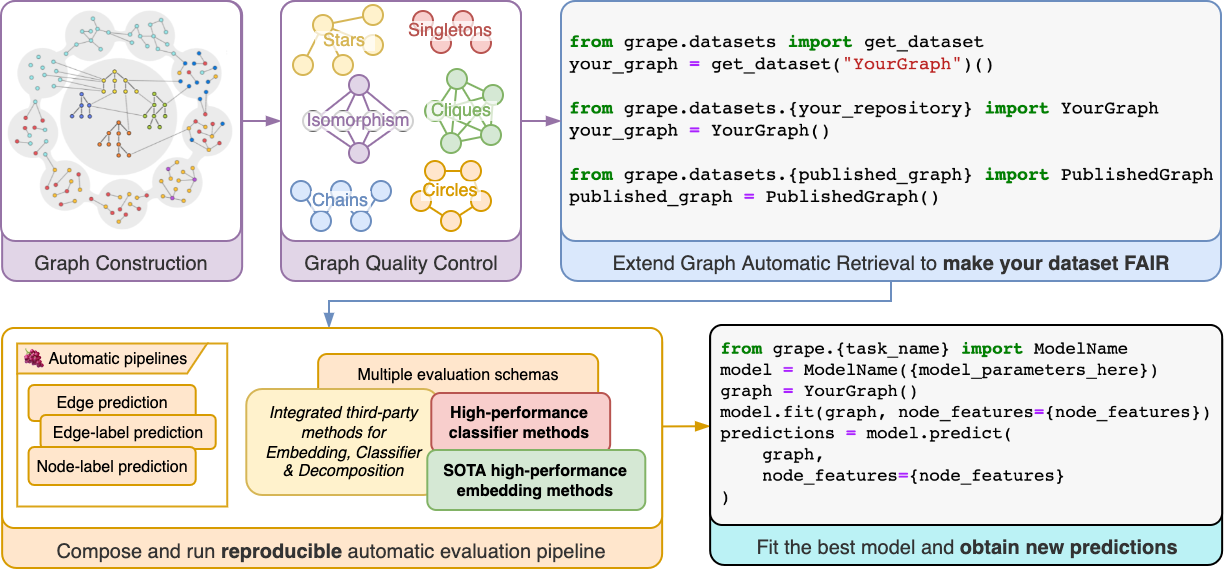🍇 GRAPE is a Rust/Python Graph Representation Learning library for Predictions and Evaluations.
Project description
GRAPE (Graph Representation leArning, Predictions and Evaluation) is a fast graph processing and embedding library, designed to scale with big graphs and to run on both off-the-shelf laptop and desktop computers and High Performance Computing clusters of workstations.
The library is written in Rust and Python programming languages, and has been developed by AnacletoLAB (Dept. of Computer Science of the University of Milan), in collaboration with the Robinson Lab - Jackson Laboratory for Genomic Medicine and with the BBOP - Lawrence Berkeley National Laboratory.
The library is composed of two main modules, Ensmallen, which is the Rust/Python high-performance graph processing submodule, and Embiggen, which is the Python Graph Representation learning, Prediction and Evaluation submodule.
Installation of GRAPE
As usual, just install it from PyPi by running:
pip install grapeGenerally, the installation does not take longer than a minute.
It is possible to manually compile Ensmallen for any OS, libc version, and CPU architecture (such as Arm, AArch64, RiscV, Mips) which are supported by Rust and LLVM. Just open an issue if you need some help.
Main functionalities of the library
- Robust graph loading and graph retrieval:
80K+ graphs
Support for multiple graph formats
human readable reports of graph characteristics
- 60+ Node embedding models, with easy integration of third parties libraries.
DeepWalk, Walklets and Node2Vec-based CBOW, SkipGram and GloVe
Unstructured, Structured Embedding, TransE
All embedding models have an MMAPP-ed versions to allow for very large embeddings
All embedding models have support for mixed precision, allowing embedding using 16 bits floats
Integrated models from Karate Club and PyKEEN
- 20+ Classifier models, with easy integration of third parties libraries.
All sklearn models, adapted for edge prediction, edge-label prediction and node-label prediction
GraphSAGE and Kipf GCN for edge prediction, edge-label prediction and node-label prediction
Baseline Perceptron for edge prediction
Integrated support to parallelize holdouts across a SLURM cluster
- Graph processing: if NetworkX has it, odds are good we have it and it is way faster!
Resnik, Jaccard, Ancestors Jaccard similarities
Diameter, Vertex cover, connected components, Triangles
Filters on graph properties and set operations on graph edges
- Graph visualization tools
TSNE, UMAP, PCA of embeddings
Edge properties
Tutorials
You can find tutorials covering various aspects of the GRAPE library here. All tutorials are as self-contained as possible and can be immediately executed on COLAB.
If you believe that any example may be of help, do feel free to open a GitHub issue describing what we are missing in this tutorial.
Documentation
On line documentation (currently being updated)
The on line documentation of the library is available here. Since Ensmallen is written in Rust, and PyO3 (the crate we use for the Python bindings), doesn’t support typing, the documentation is obtained generating an empty skeleton package. This allows to have a proper documentation but you won’t be able to see the source-code in it.
Using the automatic method suggestions utility
To aid working with the library, GRAPE provides an integrated recommender system meant to help you either to find a method or, if a method has been renamed for any reason, find its new name.
As an example, after having loaded the STRING Homo Sapiens graph, the function for computing the connected components can be retrieved by simply typing components as follows:
from grape.datasets.string import HomoSapiens
graph = HomoSapiens()
graph.componentsThe code above will raise the following error, and will suggest methods with a similar or related name:
AttributeError Traceback (most recent call last)
<ipython-input-3-52fac30ac7f6> in <module>()
----> 2 graph.components
AttributeError: The method 'components' does not exists, did you mean one of the following?
* 'remove_components'
* 'connected_components'
* 'strongly_connected_components'
* 'get_connected_components_number'
* 'get_total_edge_weights'
* 'get_mininum_edge_weight'
* 'get_maximum_edge_weight'
* 'get_unchecked_maximum_node_degree'
* 'get_unchecked_minimum_node_degree'
* 'get_weighted_maximum_node_degree'In our example the method we need for computing the graph components would be connected_components.
Now the easiest way to get the method documentation is to use Python’s help as follows:
help(graph.connected_components)And the above will return you:
connected_components(verbose) method of builtins.Graph instance
Compute the connected components building in parallel a spanning tree using [bader's algorithm](https://www.sciencedirect.com/science/article/abs/pii/S0743731505000882).
**This works only for undirected graphs.**
The returned quadruple contains:
- Vector of the connected component for each node.
- Number of connected components.
- Minimum connected component size.
- Maximum connected component size.
Parameters
----------
verbose: Optional[bool]
Whether to show a loading bar or not.
Raises
-------
ValueError
If the given graph is directed.
ValueError
If the system configuration does not allow for the creation of the thread pool.Cite GRAPE
Please cite the following paper if it was useful for your research:
@misc{cappelletti2021grape,
title={GRAPE: fast and scalable Graph Processing and Embedding},
author={Luca Cappelletti and Tommaso Fontana and Elena Casiraghi and Vida Ravanmehr and Tiffany J. Callahan and Marcin P. Joachimiak and Christopher J. Mungall and Peter N. Robinson and Justin Reese and Giorgio Valentini},
year={2021},
eprint={2110.06196},
archivePrefix={arXiv},
primaryClass={cs.LG}
}Project details
Release history Release notifications | RSS feed
Download files
Download the file for your platform. If you're not sure which to choose, learn more about installing packages.























